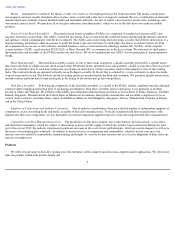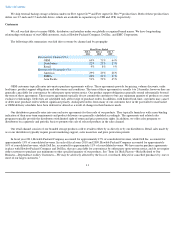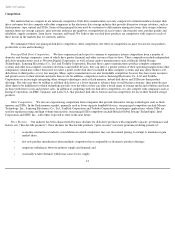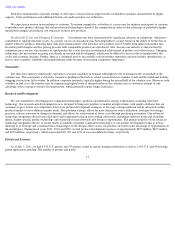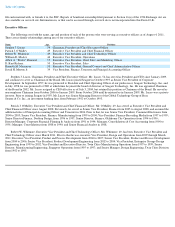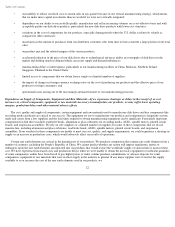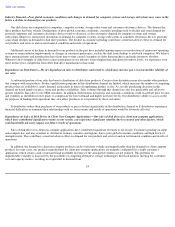Seagate 2010 Annual Report Download - page 22
Download and view the complete annual report
Please find page 22 of the 2010 Seagate annual report below. You can navigate through the pages in the report by either clicking on the pages listed below, or by using the keyword search tool below to find specific information within the annual report.
Table of Contents
decline in our market share in any of our principal market applications would adversely affect our results of operations.
Principal Competitors
—We compete with both independent manufacturers, whose primary focus is producing technologically advanced disk
drives, and captive manufacturers, who do not depend solely on sales of disk drives to maintain their profitability.
We have experienced and expect to continue to experience intense competition from a number of domestic and foreign companies,
including other independent disk drive manufacturers, and large captive manufacturers. The term "independent" in this context refers to
manufacturers that primarily produce disk drives as a stand-alone product, such as Western Digital Corporation, and the term "captive" in this
context refers to manufacturers who themselves or through affiliated entities produce complete computer or other systems that contain disk
drives or other electronic data storage products, such as Hitachi Global Storage Technologies, Samsung Electronics Incorporated and Toshiba
Corporation.
Captive manufacturers are formidable competitors because they have the ability to determine pricing for complete systems without regard
to the margins on individual components. As components other than disk drives generally contribute a greater portion of the operating margin on
a complete computer system than do disk drives, captive manufacturers do not necessarily need to realize a profit on the disk drives included in a
complete computer system and, as a result, may be willing to sell disk drives to third parties at very low margins. Captive manufacturers are also
formidable competitors because they have more substantial resources than we do. Samsung and Hitachi (together with affiliated entities) also sell
other products to our customers, including critical components like flash memory, ASICs and flat panel displays, and may be willing to sell their
disk drives at a lower margin to advance their overall business strategy. To the extent we are not successful competing with captive or
independent disk drive manufacturers, our results of operations will be adversely affected.
In response to customer demand for high-quality, high-volume and low-cost disk drives, manufacturers of disk drives have had to develop
large, and in some cases global, production facilities with highly developed technological capabilities and internal controls. The development of
these large production facilities combined with industry consolidation can further increase the intensity of competition.
We also face indirect competition from present and potential customers who evaluate from time to time whether to manufacture their own
disk drives or other electronic data storage products.
We also experience competition from other companies that produce alternative storage technologies like flash memory, where increasing
capacity, decreasing cost, energy efficiency and improvements in performance ruggedness have resulted in competition with our lower capacity,
smaller form factor disk drives. While this competition has traditionally been in the markets for handheld consumer electronics applications,
these competitors have announced solid state drives (SSDs) for tablet, notebook and enterprise compute applications. Some of these companies,
like Samsung, also sell disk drives. Certain customers for both notebook and enterprise compute applications are evaluating and may adopt SSDs
as alternatives to hard drives in certain applications.
Volatility of Quarterly Results—Our quarterly results of operations fluctuate, sometimes significantly, from period to period, and may cause
our share price to decline.
In the past, our quarterly revenue and results of operations have fluctuated, sometimes significantly, from period to period. These
fluctuations, which we expect to continue, may be occasioned by a variety of factors, including:
•
current uncertainty in global economic conditions may pose a risk to the overall economy;
•
adverse changes in the level of economic activity in the major regions in which we do business;
19


